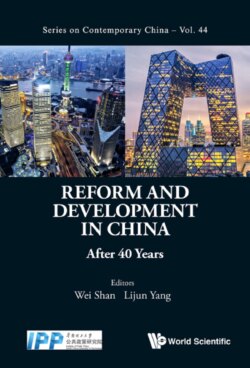Reform And Development In China: After 40 Years

Реклама. ООО «ЛитРес», ИНН: 7719571260.
Оглавление
Группа авторов. Reform And Development In China: After 40 Years
About the Editors
Contents
Introduction
Chapter. 1. China as an Innovative State and its Implications for the World
1.Introdution
Chapter. 2. A Turning Point (Maybe) in Reform and Opening Up
1.Introduction
Chapter. 3. Social and Political Mobility of State-owned Enterprise Executives in the Reform Era: The Rise of China’s Supermanagers∗
1.Introduction
2.The Emergence of Chinese Business Groups
3.Zhu Rongji’s Reforms
4.Profit and Financial Resources
5.Executive Remuneration
6.Supermanagers and the Nomenklatura System
7.System of Rotation
8.Vested Interests
9.Conclusion
Chapter. 4. Political Meritocracy and Democracy: Confucian Meritocratic Democracy?
1.Introduction
2.Empirical Critique: The Problem of “Democratic Incompetence” and China’s Practical Search for Democratic Meritocracy
2.1.New sets of problems
2.2.Regulatory control mechanisms to deal with instability or incompatibility
3.Conceptual Critique of Bell’s Three Models of Democratic Meritocracy
4.Normative Critique
5.Conclusion
Chapter. 5. Public Policy Satisfaction in Urban China: Evidence from Survey Data
1.Public Policy Satisfaction Survey in Urban China
2.Distribution of Public Policy Satisfaction
2.1.The five least satisfactory policies
2.2.The five most satisfactory policies
2.3.Historical trend of public policy satisfaction
3.Determinants of Public Satisfaction with Policy
3.1.Regional distribution
3.2.Media effect
3.3.Individual characteristics
4.Policy Satisfaction and Political Action
4.1.Types of action
4.2.Political satisfaction and political activism
4.3.Individual characteristics of political activism
5.Summary
Appendix A. Descriptive Statistics of Variables
Chapter. 6. The Chinese Voter: 1993–2013
1.Introduction
2.Categorizing the Chinese Voter
3.Who Votes? Education and Efficacy of Voters
3.1.Education
3.2.Internal efficacy
4.Values: Motivation to Participate?
4.1.Democratic orientation
4.2.Awareness of corruption
4.3.Post-materialist values
5.Satisfaction: Consequence of Participation?
5.1.Satisfaction with local government
5.2.Life satisfaction
6.Relationship with Non-conventional Participation
7.Policy Implications
Chapter. 7. China’s Social Policy Reform: The Perspective of “Fragmented Developmentalism”
1.Introduction
2.“Developmentalism” in East Asia
3.China’s Social Policy Reform: 1980s–Early 2000s
4.China’s Social Policy Reform in the 2000s
5.“Fragmented Developmentalism” in China
6.Moving Forward
Chapter. 8. Evolution of Poverty Reduction Strategies in Rural China
1.Introduction
2.Literature Review
2.1.Rural poverty in China: A background
2.2.Measurement of poverty
2.3.Poverty reduction programs in rural China
2.4.The impact of development programs on rural poverty reduction
2.5.Urban–rural integration in Chongqing33
3.Discussion for Poverty Reduction Strategies
Chapter. 9. The Rise of New Green Industries: A Dynamic View of China’s (and India’s) Eco-Modernizing Experience∗
1.Introduction
2.Industrial Transitions
3.Eco-modernization
4.China and India as Eco-modernizing Powers
4.1.China’s “black” face — an enormous coal-fired energy system
4.2.China’s green face — an enormous renewables-based energy system
5.India
6.Manufacturing as the Key to Eco-modernization
7.Concluding Remarks
Chapter. 10. China’s Bet on Technological Progress as an Engine of Sustainable Growth
1.Introduction
2.Driving Factors for the Hyper-Growth
3.Transition to the New Normal
4.National Strategy of S&T: From Gan-Chao to Kejiao Xingguo27
4.1.Gan-chao: Catching up in S&T to support growth and modernization
4.2.The Kejiao Xingguo strategy to sustain development
5.Effectiveness of S&T Catch-up and Innovation. 5.1.Input and capacity building
5.2.Output: Technology catch-up and indigenous innovation
5.3.Overall national innovation
6.Concluding Remarks
Index
Отрывок из книги
Series Editors:Joseph Fewsmith (Boston University) Zheng Yongnian (East Asian Institute, National University of Singapore)
This series showcases the most significant and lasting contributions to scholarship in the studies of China’s politics, society, and culture — whether for general readers or specialists. Each of the volumes is a quality work by a leading scholar or scholars in the field and may take the form of a research monograph, a multi-author edited volume, a conference proceeding, a textbook, or an annual review, among others. While the focus is on China, the series does not lose sight of the interplay of other regional and global forces and their influence and impact on China.
.....
A key feature of China’s party system is that political openness has facilitated the rapid alternation of political elite in a highly institutionalized manner. The nature of Western democracy is to realize peaceful alternation of political elites through periodical elections. China has steadfastly refused to follow the path of Western democracy; instead, it has developed a very efficient system of power succession. The late Deng was successful in establishing a number of important political institutions, including term limits, age limits and collective leadership.
The first is the term limit. The term limit matters. In general, leaders including the General Secretary of the CCP, the President of State, Premier and other important positions are allowed to serve at most two terms in office, i.e., 10 years. This system is not hugely different from many Western presidential systems. Obviously, the term limit is an effective institutional tool to prevent personal dictatorship which was prevalent under Mao, and to a lesser degree, under the late Deng. That is to say, although China does not have a Western form of democracy, it has found an alternative way to prevent personal dictatorship. When a person or a family has dominated a country for several decades, the system is prone to malpractices and abuses, which are unacceptable to the society.
.....